Excerpts from Jim Conrad's
Naturalist Newsletter
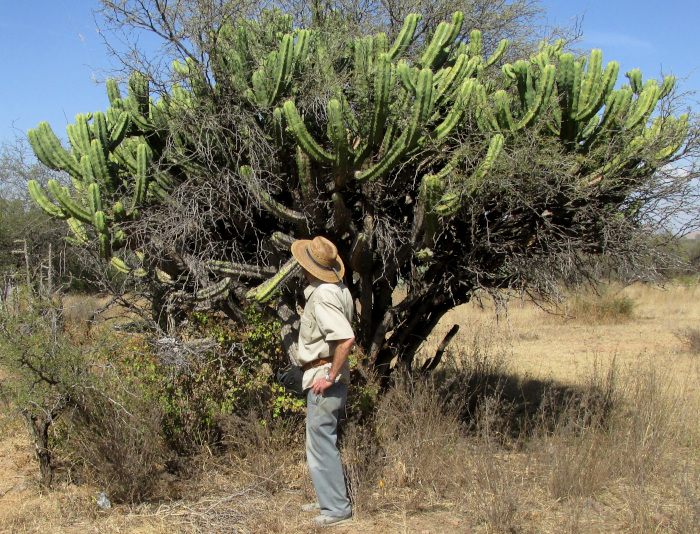
Entry issued January 20, 2022, from near Tequisquiapan, elevation about 1,900m (6200 ft), ~N20.57°, ~ W99.89°, Querétaro state, MÉXICO
GARAMBULLO FLOWERING
Garambullo cacti, sometimes known in English as Bilberry, Whortleberry and Blue Cactus, MYRTILLOCACTUS GEOMETRIZANS, is common in this area, and above you can see that they are an eye-catching presence. Nowadays they're among the earliest-flowering species we have here, as shown below:
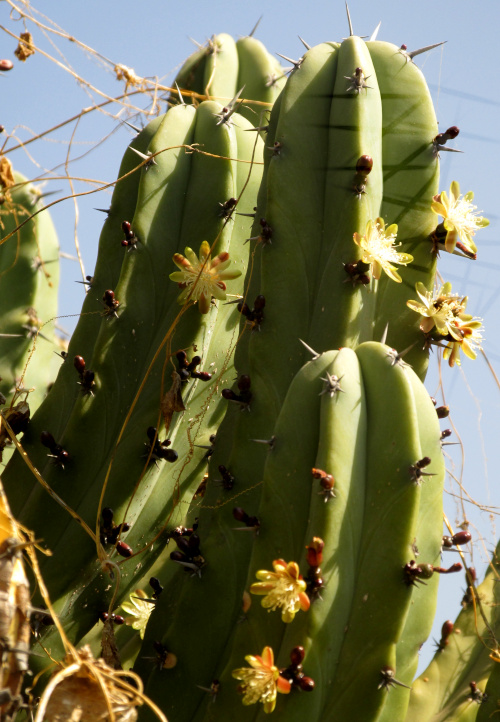
It's typical that bushes, vines and small trees grow up through the Garambullo's branches, just as in the top picture. On mature plants, toward branch tips, many ribs bear clusters of small, purplish ovaries topped with unopened corollas -- they're "inferior ovaries" -- and a few yellowish flowers are appearing. Ants and flies tend to be attracted to the immature ovaries but I can't see that they're collecting anything. Below you can see how the floral parts arise from atop the ovary, the future fruit:
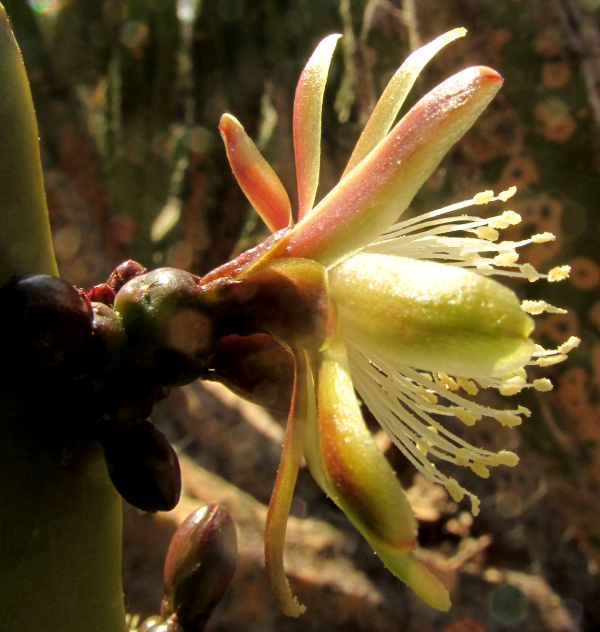
Below, a view from the front showing a flower's numerous white stamens surrounding thick stigma lobes, arising amid numerous "tepals," which are what you call corolla petals and calyx sepals when they are indistinguishable from one another -- all normal for flowers of the Cactus Family.
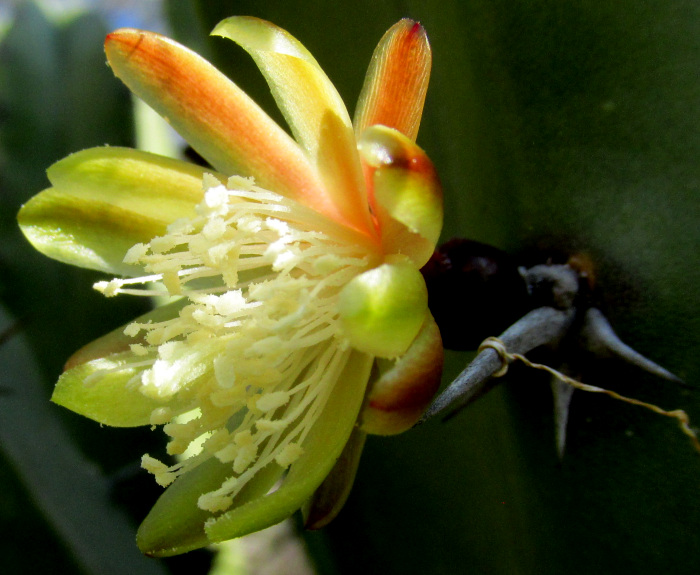
The spines arise in clusters atop the branches' ribs. A cluster typical of those toward a branch's tip is shown below:

Typically in this species the clusters have 3-9 spines, most commonly 3-5, with the central spine much larger than those at its base. They're woody and hard.
The species is endemic just to the highlands of central and northern Mexico, and occurs between 1000-2000 meters (3300-6600ft).
People around here look forward to the fruits, which look like large, plump, purple blueberries, and are said to taste good. I hope later to try some, and there ought to be plenty, judging from all the flowers.
Entry issued May 20, 2022, from near Tequisquiapan, elevation about 1,900m (6200 ft), ~N20.57°, ~ W99.89°, Querétaro state, MÉXICO
GARAMBULLO FRUITING
At the end of the dry season, before any good rain has materialized since last December, Garambullo fruits are just beginning to ripen, as shown below:
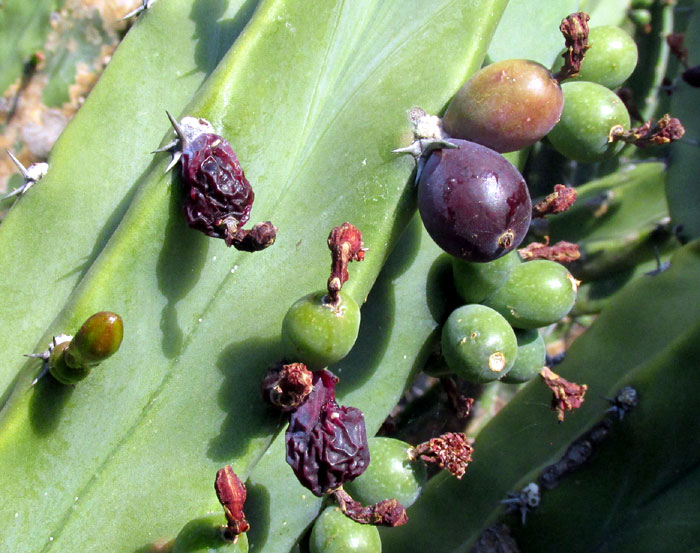
At first I ignored the shriveled ones, going directly to the plump, purple ones. They were juicy and sweet, almost like grapes on the vine, but without the grapes' hard seeds. Their seeds were tiny and could be swallowed, as when eating figs. There weren't many fruits in the plump stage, though, so I tried some beginning to shrivel, and they were sweeter, better tasting. In fact, the most wrinkled, dehydrated ones were by far the best tasting, almost as good, and very similar, to raisins.
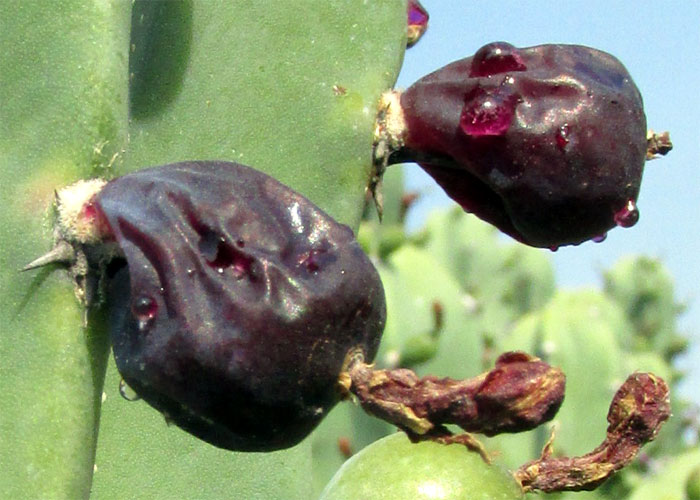
As shown above, many fruits just beginning to shrivel were expelling moisture in droplets from their skin.
Garambullo fruits are wonderful, and I've been eating all I want every day, always thinking of the what a delight they must have been to ancient humans trying to survive this very harsh, long dry season.
 Entry issued January 25, 2021, from near Tequisquiapan, elevation about 1,900m (6200 ft), N20.565°, W99.890°, Querétaro state, MÉXICO
Entry issued January 25, 2021, from near Tequisquiapan, elevation about 1,900m (6200 ft), N20.565°, W99.890°, Querétaro state, MÉXICO
GARAMBULLO "CRISTATA"?
Along a dusty little street in a small village near Tequisquiapan, the shoulder-tall cactus at the right can be seen growing. It's unlike any naturally occurring cactus in the area and at first I had no idea how to identify it.
However, when I looked closely at its spines, I got a hint as to where to begin. They were similar to, but not exactly like, the big Garambullo commonly occurring in the region. Below, you see what they looked like:
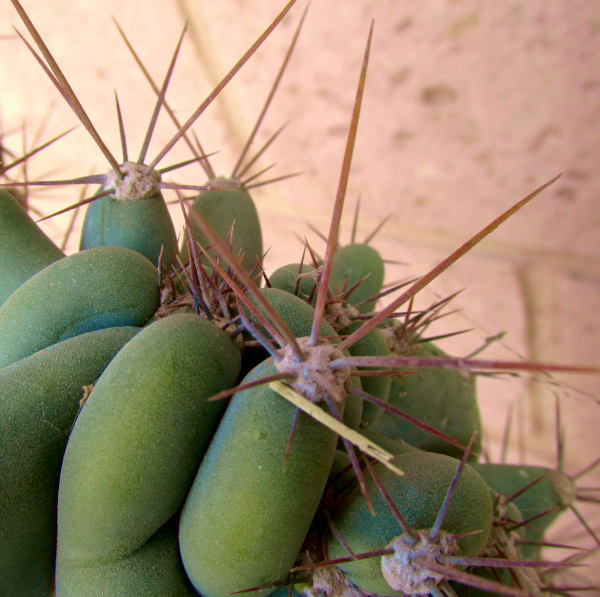
Knowing how important spine configuration is for identifying cacti, I took the close-up of a single cluster, shown below:
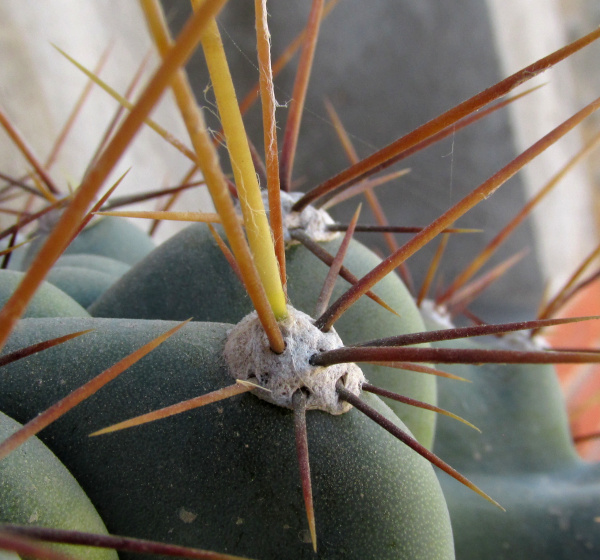
On the Internet, a search on "Myrtillocactus geometrizans cultivars" resulted in very many images showing a popular cultivar of the Garambullo, much sold in pots and for gardens, the "forma Cristata." However, all Cristata pictures I found looked somewhat different from our streetside plant, plus they bore no spines, or only much diminished or randomly occurring ones. The few individuals with spines usually produced 0-5 dwarf ones per cluster. The above picture shows ten long spines in the cluster. Our streetside Garambullo cultivar was so different from "Crista" that I wondered if it really was based on our Garambullo.
However, even among commercially sold Cristata plants there is a good bit of variation in appearance, plus other cultivars are available looking more like ours, but still quite different -- such as the "Fukurokuryuzinboku" cultivar. Moreover, a "natural hybrid" with our Garambullo from the nearby state of San Luis Potosí has been documented, Isolatocereus dumortieri x Myrtillocactus geometrizans.
It looks like Garambullo is one of those species whose genes are especially vulnerable to manipulation. Also, that our streetside plant probably is one of those products, possibly a rare or unique individual plant.
I'll be looking forward to any insight someone else may offer.